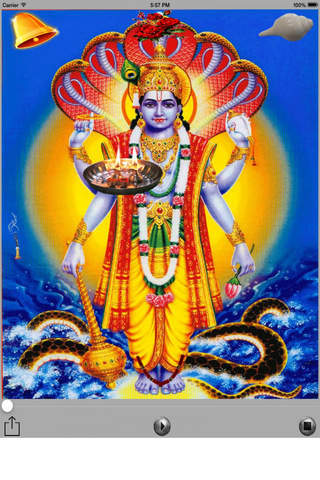
Vishnu Aarti / Vishnu Pooja - Yogeshwar Virtual Aarti
Vishnu Pooja Vishnu Temple is a temple, mandir, vishnu nu mandir to worship the god without going to maandir. You can do live aarti, live darshan at your mobile finger tips. Application contain vishnu wallpaper and devotee can worship her. All things together acts as a live wallpaper too.
See Application Fuctions Are Listed Below:
1). You can play shank.
2). You can play bell / Ghant / Ghanta.
3). You can play aarti with small ganti / bell.
4). Flowers to offer.
5). You can offer flowers mala also
Vishnu is a popular Hindu deity. He is the Supreme God of Vaishnavism, one of the three most influential denominations in contemporary Hinduism. He is also known as Lord Narayana, the Supreme God and also known as Lord Hari. He is one of the five primary forms of God in the Smarta tradition, and "the Preserver" among the Trimurti, the Hindu Trinity of the primary aspects of the divine.
In Hindu sacred texts, Vishnu is usually described as having dark complexion of water-filled clouds and as having four arms. He is depicted as a blue being, holding a padma (lotus flower) in the lower left hand, the Kaumodaki gada (mace) in the lower right hand, the Panchajanya shankha (conch) in the upper left hand and the discus weapon Sudarshana Chakra in the upper right hand.
Adherents of Hinduism believe Vishnus eternal and supreme abode beyond the material universe is called Vaikuntha, which is also known as Paramdhama, the realm of eternal bliss and happiness and the final or highest place for liberated souls who have attained Moksha. Vaikuntha is situated beyond the material universe and hence, cannot be perceived or measured by material science or logic. Vishnus other abode within the material universe is Ksheera Sagara (the ocean of milk), where he reclines and rests on Ananta Shesha, (the king of the serpent deities, commonly shown with a thousand heads). In almost all Hindu denominations, Vishnu is either worshipped directly or in the form of his ten avatars, the most famous of whom are Rama and Krishna. The Puranabharati, an ancient text, describes these as the dashavatara, or the ten avatars of Vishnu. Among the ten described, nine have occurred in the past and one will take place in the future as Lord Kalki, at the end of Kali Yuga, (the fourth and final stage in the cycle of yugas that the world goes through). These incarnations take place in all Yugas in cosmic scales; the avatars and their stories show that gods are indeed unimaginable, unthinkable and inconceivable. The Bhagavad Gita mentions their purpose as being to rejuvenate Dharma, to vanquish those negative forces of evil that threaten dharma, and also to display His divine nature in front of all souls.
The Trimurti (three forms) is a concept in Hinduism "in which the cosmic functions of creation, maintenance, and destruction are personified by the forms of Brahma the creator, Vishnu the maintainer or preserver, and Shiva the destroyer or transformer." These three deities have also been called "the Hindu triad" or the "Great Trinity", all having the same meaning of three in One. They are the different forms or manifestation of One person the Supreme Being or Narayana/Svayam Bhagavan.
Vishnu is also venerated as Mukunda, which means God who is the giver of mukti or moksha (liberation from the cycle of rebirths) to his devotees or the worthy ones who deserve salvation from the material world.

